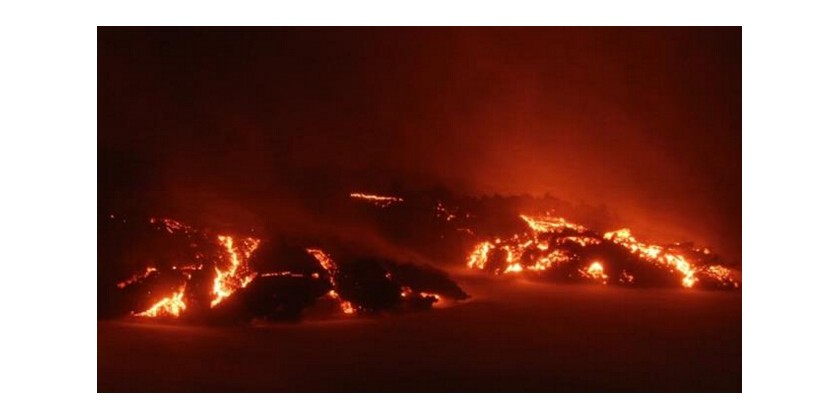Reykjavik, Iceland - For the past five months, Icelandic weather forecasts have included daily updates on the movement of noxious gas plumes emitted by the ongoing Holuhraun volcanic eruption.
Poisonous gas appeared in late August last year soon after Holuhraun began to spew molten rock. "Most of the gas is sulphur dioxide, water and carbon dioxide," said Thorolfur Gudnason, a medical professional with Iceland's Directorate of Health. "The other gases occur in much lower quantities."
Sulphur dioxide, which causes respiratory, eye and throat problems, is responsible for most of the eruption-related health issues, said Gudnason.
"But carbon dioxide can be dangerous to those who work near the volcano itself," he said, referring to scientists studying the lava field.
The 85sq km lava field is the size of Manhattan and located far from inhabited areas in a remote central part of Iceland, just north of the Vatnajokull glacier in an area known as Holuhraun, from which the volcano gets its name.
Unlike the smaller, 2010 Eyjafjallajokull eruption, which spouted ash and disrupted air traffic across Europe, Holuhraun doesn't spew ash - this only happens when the eruption occurs beneath a glacier.
But the gas emitted is the most dangerous the country has experienced in more than 200 years.
"We have not seen such levels of gas in Iceland in recent times, not since the Laki eruption in 1783," said Evgenia Ilyinskaya, a volcanologist with the British Geological Survey studying the Holuhraun emissions.
The devastating eruption of Laki started in June 1783 and lasted until February 1784 - wiping out a fifth of Iceland's population.
This eruption is a first in many ways, said Ilyinskaya. "Normally eruptions don't last so long," and it's the largest and only European basalt flood eruption since Laki.
Monitoring toxic gases
With volcanic gas emissions at such high levels, Icelandic authorities have installed 27 automatic monitors around the country that measure sulphur dioxide along with portable meters, some of which are attached to police vehicles.
Depending on wind conditions, sulphur fumes can get blown around and the entire country, sometimes exceeding 2,000 µg/m3 at different points throughout a day.
The Environment Agency set 350 µg/m3 for a one-hour period and 125 µg/m3 for a 24-hour period as acceptable exposure limits to sulphur dioxide. When the concentration rises, advisories are posted online, via Facebook and by SMS, and Icelanders are advised to avoid going outdoors and engaging in physical activity.
Levels more than 600µg/m3 are considered dangerous for people who have existing health conditions and are more likely to experience respiratory problems. At these levels, such people are advised to stay indoors with the windows closed.
Meteorologist Einar Sveinbjornsson is concerned about the longer-term and lesser-known affects of exposure to low levels of sulphur dioxide. But there's also another aspect of sulphur dioxide that troubles him - when it reacts with water it turns into sulphuric acid and becomes far harder and more expensive to monitor.
"Sulphuric acid becomes apparent over a longer time period than sulphur dioxide and typically further from the centre of the eruption," he said pointing out the 1783 Laki eruption also killed an estimated 20,000 people in Britain, likely through exposure to sulphuric acid.
Occasionally, the sulphur dioxide plumes, appearing as a bluish haze, have reached the capital of Reykjavik on the west coast. But eastern Iceland has been particularly susceptible to high gas concentrations. Schools have sometimes been closed and Gudnason said sales of asthma drugs have spiked in the country's east with "indications that various respiratory symptoms may have increased".
On January 11, a portable meter picked up a reading of 7,800 µg/m3 about 80km east of the eruption.
Sigvaldi Ragnarsson, a sheep farmer in the area, said when he went outdoors that day he felt a burning sensation in his throat and eyes. He said the gas built up steadily and stayed for about six to eight hours.
Previously, there had been a higher reading at 8,000 µg/m3, but he said his symptoms this time were worse, and the pollution was so thick that when he went into the sheep shed he couldn't see the other end of the building.
Ragnarsson said he is now worried his livestock could wind up with long-term damage, as they have been holed up inside the shed with poor air circulation. "It wouldn't surprise me if the youngest sheep end up with some health problems, such as weaker lungs," he said.
Sulphuric acid is currently stored in the snow ... [the product of volcanic sulphur dioxide reacting with water in the atmosphere acidified the snow]. It is only when the snow melts in spring [that sulphuric acid will affect the water, soil and vegetation].
Gisli Mar Gislason, University of Iceland
Scientists working at the lava field can be exposed to other gases, such as odourless carbon monoxide.
Ilyinskaya, the volcanologist, was with a group that evacuated a site after detecting a carbon monoxide concentration of 25ppm - the maximum exposure time for this is eight hours.
"This concentration is not critically dangerous to human health," she said, but they evacuated as a precaution. "We travelled some distance to a higher ground until the gas sensor showed a zero level of carbon monoxide."
Iceland's volcanic eruption stokes toxic gas fears
News Apr 29, 2016







